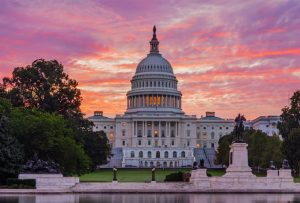
-Editorial
The United States is in the midst of its 11th government shutdown since 1976, following a political impasse over spending limits, reductions in foreign aid, and health care subsidies. The latest funding lapse, which began earlier this month, has led to widespread disruptions across federal agencies and raised concerns about the economic impact nationwide.
The shutdown comes six years after the record-long 35-day closure in 2018–2019 and could ultimately rival it in length and severity. According to government estimates, roughly 900,000 federal employees have been furloughed, while nearly 700,000 are continuing to work without pay.
Unlike previous shutdowns, uncertainty remains over whether all federal workers will eventually receive back pay once the government reopens. Some agencies have warned of potential permanent layoffs if the funding impasse continues. Essential operations, such as air traffic control, border protection, and military functions, are ongoing, but many civilian agencies — including the Internal Revenue Service, the Department of Education, and the Centers for Disease Control and Prevention — have scaled back or paused their activities.
The shutdown is costing the U.S. economy approximately $400 million per day, according to new data compiled by WalletHub, which analyzed how the funding lapse is affecting each state. The personal finance website ranked all 50 states and the District of Columbia across five key metrics: share of federal jobs, federal contract dollars per capita, percentage of families receiving Supplemental Nutrition Assistance Program (SNAP) benefits, real estate as a percentage of gross state product, and access to national parks.
The analysis found that the District of Columbia, Hawaii, and New Mexico are the states most affected by the partial government shutdown, while Minnesota, Iowa, and Indiana are the least impacted.
WalletHub analyst Chip Lupo said that the effects of the shutdown are especially pronounced in areas where the federal government plays a major economic role.
“The latest government shutdown makes life stressful for people across the U.S., but places like D.C. and Hawaii, where a high percentage of residents work directly for the government or have government contracts, are getting hit the hardest,” Lupo said. “States with a lot of residents who receive SNAP benefits, such as New Mexico, could be in a dire situation if money for this vital program runs out before the gridlock ends.”
The District of Columbia tops WalletHub’s list, with a total score of 76.33. More than one in four jobs in D.C. are connected to the federal government — the highest percentage in the nation. The city also receives the largest amount of federal contract dollars per capita, at over $50,000. With many agencies closed, local contractors and small businesses that depend on government projects are feeling the immediate strain.
Beyond employment, the shutdown could also threaten D.C.’s social safety net. The district has the second-highest share of residents receiving SNAP benefits, which could be at risk if the deadlock persists and funding runs out.
Hawaii, ranked second, is far from the nation’s capital but remains heavily dependent on federal spending. About 5.6% of the state’s workforce holds federal positions, and real estate — accounting for nearly 23% of its gross state product — is already being affected by processing delays in the IRS, Federal Housing Administration, and Department of Veterans Affairs. Those delays could stall mortgage approvals and dampen housing market activity.
Hawaii’s extensive network of national parks could also see consequences. With reduced staffing and maintenance, certain facilities and visitor centers may be closed, potentially disrupting tourism and reducing state revenue.
New Mexico, ranked third, faces similar vulnerabilities. The state receives more than $6,000 in federal contract dollars per capita, but many of those projects are now on hold. Additionally, more than 20% of New Mexico’s residents depend on SNAP benefits, putting pressure on low-income households as the shutdown drags on. The state also ranks high in federal employment and access to national parks, both of which are being affected.
Other states ranking among the top 10 most affected include Alaska, Maryland, Virginia, West Virginia, Alabama, Oklahoma, and Arizona. All have significant federal employment and contracting activity. Maryland and Virginia, which border the nation’s capital, are particularly vulnerable due to their large number of federal employees and defense-related industries.
Conversely, states such as Iowa, Minnesota, and Indiana rank among the least affected. These states have smaller federal workforces, fewer national parks, and lower dependence on federal contracting.
Economists warn that a prolonged shutdown could have far-reaching effects. Beyond the loss of productivity, delayed paychecks and contract payments may reduce consumer spending and slow local economies — particularly in regions reliant on federal payrolls. Real estate transactions, research grants, and small business loans are also being delayed due to suspended operations at key agencies.
The Congressional Budget Office estimated that the 2018–2019 shutdown cost the economy $11 billion, with about $3 billion permanently lost. Analysts caution that if the current stalemate extends for several more weeks, the financial toll could exceed those figures.
WalletHub’s analysis used publicly available data from the U.S. Census Bureau, Bureau of Labor Statistics, USAspending.gov, the National Association of Realtors, and the National Park Service as of Oct. 11, 2025. The report weighted the share of federal jobs and SNAP participation most heavily in determining each state’s ranking.


